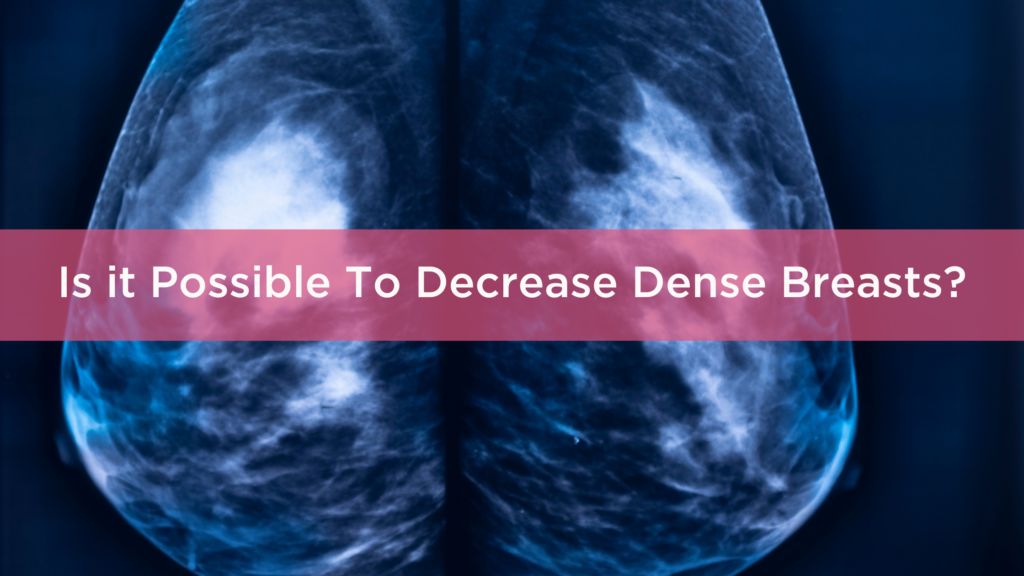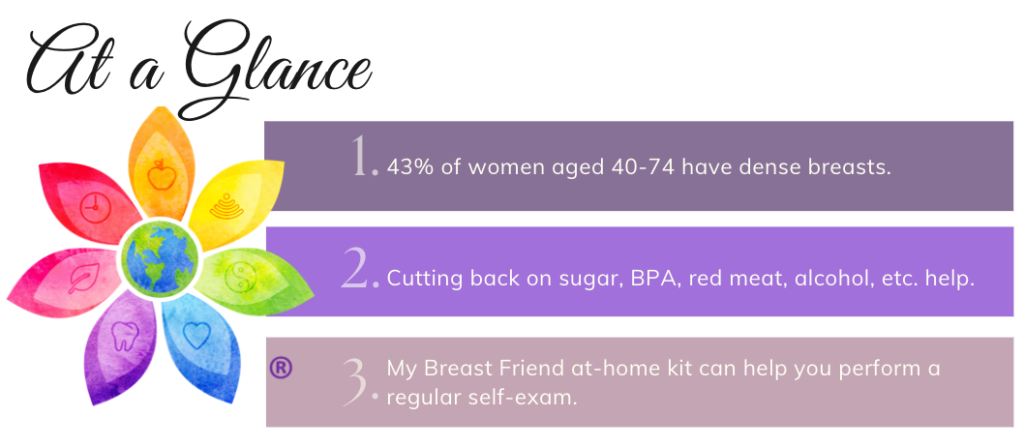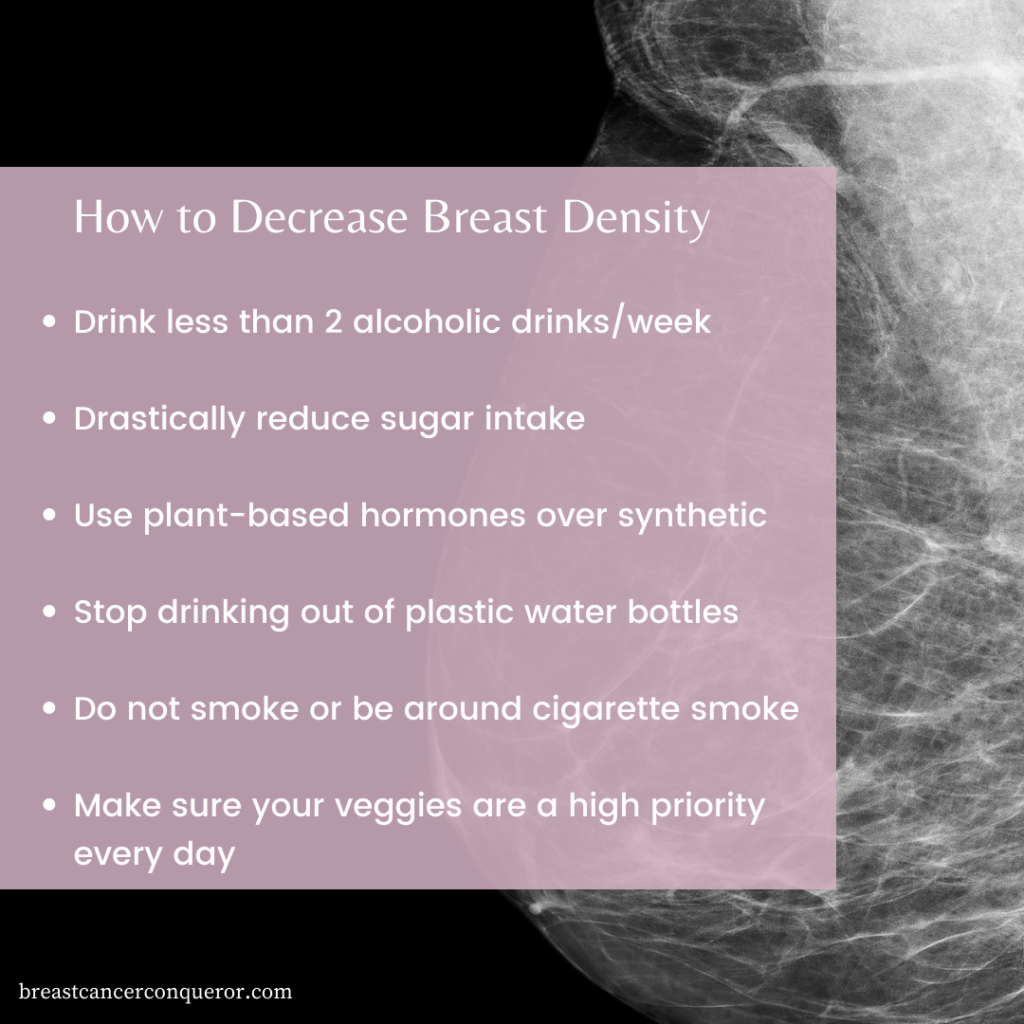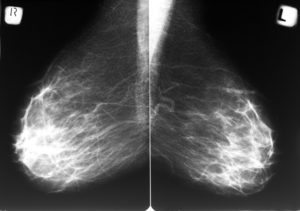

A joint study by the University of Vermont, the University of Wisconsin, UC Davis, and others found that a shocking 43% of all women aged 40-74 years have a dense breast diagnosis.
The Mayo Clinic broke these numbers down by stating about 1 in 10 women will have “D” Classification breasts (extremely dense) while 4 in 10 women will have “mostly dense tissue.” Another 4 in 10 will have scattered areas of dense tissue in their breasts.
This is a heavy issue for people with dense breasts as mammograms do not work as well since the density may hide a tumor. Even in normal breasts, by the time cancer is detected via a mammogram, breast cancer could have been in the body for an average of 6-8 years. Yes, if you have extremely dense breasts, studies indicate your chances of breast cancer may be higher than normal. BUT it does not mean breast cancer is inevitable. I highly recommend that you are PROACTIVE with PREVENTION and REVERSAL.
Keep on reading to learn a few practical steps to start taking. If you want personalized and actionable support, please look into working with a Breast Cancer Conqueror Coach today.
What does the term “dense breasts” mean?
Breast tissue is fatty, glandular, and fibrous tissue, and the amount of each can vary depending on the woman. When the amount of fatty tissue in a woman’s breasts is significantly lower than fibrous and/or glandular tissue, a physician may give a diagnosis of “Dense Breasts” or “Dense Breasts Syndrome (DBS).”
There are several “classifications” of breast density that you may already be aware of from your doctor visits. In case you are not aware of the classifications breakdown or need a refresher on the Breast Imaging Reporting and Data System (BI-RADS) system put out by the American College of Radiology—here it is:
“A” Classification indicates that a woman’s breasts are “almost entirely fatty tissue.”
“B” Classifications mean there are “scattered areas” of dense breast tissue.
“C” Classification indicates “heterogeneously dense breast tissue,” i.e. many areas contain glandular and fibrous tissue.
“D” Classification means that a woman has “extremely dense breast tissue.”
What causes dense breasts?
Conventional medicine states that dense breasts are an “inherited trait.” It also acknowledges, however, that certain epigenetic factors absolutely play a part in the expression of this trait. A quick recap on epigenetics: Epigenetics is the study of how your lifestyle and environment can cause changes that affect the way your genes express themselves. (CDC).
Breast tissue develops primarily during puberty and is altered during pregnancy, breastfeeding, and menopause. Additionally, how you take care of yourself (especially during the stages mentioned above), along with dietary and environmental factors, will play a huge role in the density of your breast tissue. That is epigenetics at work.
Alcohol
Since March 2020 (mostly due to the pandemic), heavy drinking amongst American women has increased by 41%. Alcohol is a toxin, plain and simple. The ethanol breaks down to acetalehyde wich is a known carcinogen and is a leading cause of a range of cancers and serious illnesses. For example, women who consume more than 7 drinks a week are 5 times likelier to have dense breasts. Even more damaging, drinking more than 1 glass a day leads to a drastic 82% greater risk of breast cancer. Save your money, save your life—opt-in for lavish mocktails like this sparkling lemon fizz!
If you do want to enjoy an occasional glass of wine, only drink wine that is organic, has been tested for chemicals, has no added sugars and sulfites. I discovered a company called Dry Farm Wines which locates small family vineyards that use no additives and chemicals in their wine-making. They do not irrigate their vineyards which saves millions of gallons of water and creates a healthier more robust wine. It’s hard to tell, but most wines sold today are mass produced products. They can include high levels of added sugar, alcohol, and 76 FDA-approved additives.
If you would like to try a few bottles, you can get an additional bottle for 1 penny on your first order.
Sugar and the “Western Diet”
Putting refined sugars into your body increases insulin production and eventually inflammation. Insulin resistance increases cellular proliferation in breast tissue and thus increases breast density and risk for cancer. Women who eat commercialized grain-fed red meat every single day in their adolescent years and presently, are associated with a 22% higher risk of dense breasts and breast cancer. If you choose to eat red meat, make sure it is hormone-free and 100% grass-fed. A small portion no bigger than a deck of cards is all you need.
Hormones and Synthetic Hormone Replacement Therapy (SHRT)
We all know that when your hormones are out of balance, things can feel pretty miserable. Balancing hormones is also critical for preventing serious health concerns. Some of these include polycystic ovarian syndrome (PCOS), Endometriosis, premature aging, and potentially breast cancer. However, synthetic/pharmaceutical hormones are NOT the answer. Additionally, the use of the birth control pill and an increase in weight gain in adulthood (which causes a change in your hormones) lead to denser breast tissue. Learn more about healthy breast-safe hormones to use via this blog.
Plastics, BPA, and Phthalates
All of them are known endocrine-disrupting compounds linked to breast cancer, dense breasts, and many hormonally driven conditions. One massively helpful change you can do right now is to stop using throw-away plastic water bottles. Over 38 pollutants were found in 10 of the best-selling bottled water brands. Also, you don’t know how long your case of plastic water bottles has been sitting in the hot sun before winding up in your shopping cart. I go into great detail about how to clear out environmental toxins in my book, Heal Breast Cancer Naturally.
Actions that lead to decreasing dense breasts
Balancing your hormones naturally: If you tend to be estrogen dominant, saliva hormone testing can help you understand how your hormones are working or not.
Monitor your breasts (and whole-body) with safe and effective imaging: You have OPTIONS! The mammogram isn’t the only test—especially if you have dense breasts. Check out why thermography gave me one of the biggest light bulb moments (personally and professionally)! Another amazing option for dense breasts is The SonoCiné Ultra Sound AWBUS.
A balanced diet: Eating a well-rounded diet specifically based on your genes, nerve system, or blood type is essential for decreasing the dense breast tissue. Drinking matcha tea, consuming 45 mg/day of fiber (chia and flax seeds are a great source), and enjoying 6 servings of vegetables are all great ways to eat away cancer.
Get lost in learning and find answers! Start with listening to this brilliantly insightful podcast about mammography & dense breasts, and check out www.areyoudense.org policy, news, and education around breast density.
Lastly, be your own breast detective—never stop researching and looking for clues!


